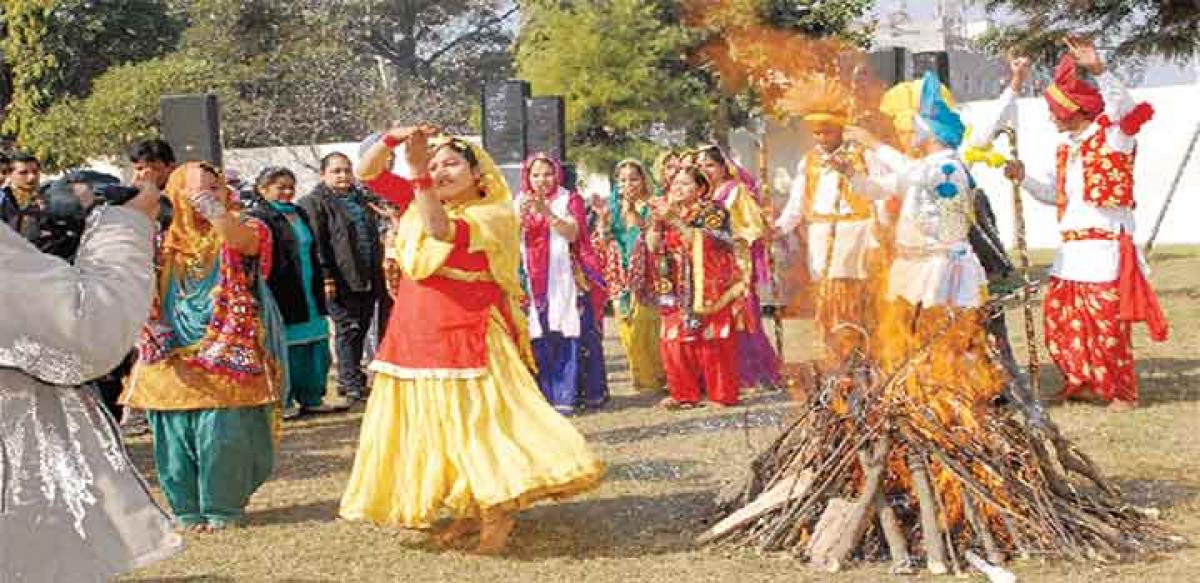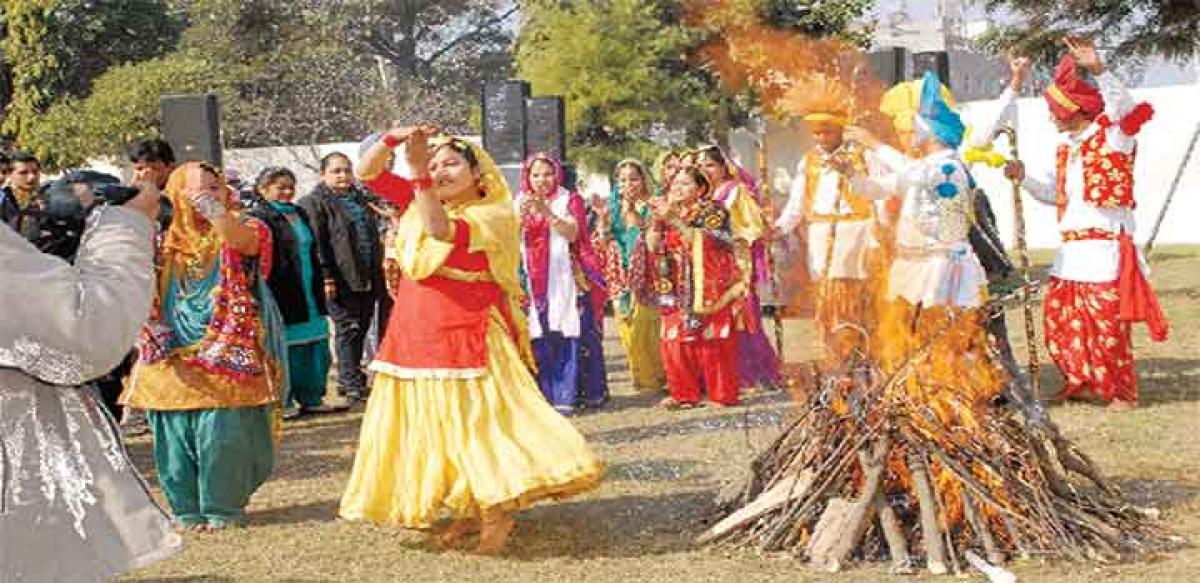Live
- IPL 2025 Auction: Pant was always in our bucket list, says LSG's Shashwat Goenka
- Andhra Pradesh's Bold New Strategy to Fix Highways Forever
- Asia-Pacific’s EV battery market to reach 29.9 mn units by 2029, India’s FAME makes strides
- Samajwadi Party slams UP govt over Sambhal violence, calls it orchestrated
- BGT 2024-25: Very proud of the way we came back after being put under pressure, says Bumrah
- CBI gets evidence about circulation of expired medicines on RG Kar campus
- Now complaint filed with Governor against Karnataka Minister M.B. Patil
- Ragging Scandal at Khammam Medical College: Professor Faces Action for Shaving Student’s Head
- More Waqf notices issued during BJP's tenure: Karnataka HM on statewide stir plans
- More Waqf notices issued during BJP's tenure: K'taka HM on statewide stir plans
Just In

People sing, dance with a lot of enthusiasm. These dances are called Bhangra and Gidda in Punjab. These songs and dances portray the various stages in our lives. They reflect the socio-religious customs and practices of rural people earlier, but now are a part of modern city culture also. No school programme is complete without them.
Music, dance, drama, folk theatre or puppetries are all in abundance in our country. Lohri which is normally held on 13th January every year in the Northern part of our country is an example of folk art

People sing, dance with a lot of enthusiasm. These dances are called Bhangra and Gidda in Punjab. These songs and dances portray the various stages in our lives. They reflect the socio-religious customs and practices of rural people earlier, but now are a part of modern city culture also. No school programme is complete without them.
They are linked through centuries of celebration and might have started with fertility rites to obtain prosperity for the agricultural community i.e. fertility of land and cattle but also of birth and survival of children. There are many reasons for celebration that it is difficult to list them. Why don’t you make a list of these activities and find out how and why people celebrate them.
You will not only find this activity interesting but you will be unable to put a full stop to it. Do you know why? Because the number is so large that you will never be able to know all the music, dance and drama that our country has. India is a land of rich culture and heritage. Since the beginning of our civilization, music, dance and drama have been an integral aspect of our culture.
Initially, these art forms were used as medium of propagation for religion and social reforms in which music and dance were incorporated to gain popularity. From the Vedic era to the medieval period, the performing arts remained an important source of educating the masses. The Vedas laid down precise rules for the chanting of Vedic hymns.
Even the pitch and the accent of singing different hymns have been prescribed. There was more of exemplary presentation through them than education or social reforms. Presently, these art forms have become means of entertainment for people all over the world.
Concept of performing art
What is art? “Art is an expression of all characteristics of the human mind aesthetically”. These characteristics, i.e. the varied human emotions, are known as ‘RAS’. In Hindi, ‘ras’ literally means a sugary juice. It signifies the ultimate satisfaction of ‘aanand’. Human emotions can be categorized into nine sub-headings or ‘navras’. They are:
- Hasya — laughter
- Bhayanak — evil
- Shringar — aesthetics
- Rudra — chivalrous
- Karun — pathos
- Vir — courage
- Adbhut — astonishing
- Vibhatsa — terrifying glory
- Shaanti — peace
- Shringaar — decorating one’s self
Art reflects human emotions and human beings spontaneously express their frame of mind through various art forms. Thus the intellectual mind merges with the artistic streak, giving birth to art. The expression is reflected in various styles like singing, dancing, drawing, painting, acting, sculpture.
Some of these are expressed through live performances and others through visual arts. Sketching, painting, sculpture are visual arts. Singing, dancing, acting are attributes of performing arts. Music from time immemorial has been the most popular art form of India. They are Sa, Re, Ga, Ma, Pa, Dha, Ne.
The earliest tradition of Indian music may be traced to Sama Veda which contained the slokas that were put to music. Chanting of Vedic hymns with prescribed pitch and accent still form a part of religious rituals. The earliest text dealing exclusively with performing arts is Bharata’s Natyashashtra (compiled between second century BC and second century AD) which has six chapters on music.
Another major text is Matanga’s Brihaddesi compiled between eight and ninth century AD. In this work ragas were first named and discussed at great length. Sangeet Ratnakara written by Sarangdeva in the thirteenth century mentions 264 ragas. A variety of string and wind instruments were invented over the period of time. In ancient texts references have been made to flutes, drums, veena, and cymbals. Many rulers such as Samudragupta, King Bhoja of Dhara and King Someshavra of Kalyana patronised music.
The Gupta monarch Samudra Gupta was himself an accompolished musician. In some of his coins, he is shown playing on the Veena. Music was also associated with the worship of Gods and Goddess in the temples. In the twelfth century, Jayadeva of Orissa produced the most brilliant raga kavya, the Gita Govinda, each song of which was set in a raga and was composed on the theme of love of Radha and Krishna.
Abhinavagupta’s (993-1055) Abhinavabharati provides useful information about music. Tamil music has a number of terms and concepts parallel to what is found in Sanskrit texts. The Saivite Nayanars and Vaishnavite Alvars too set their psalms (poems) to music.
Similarly in the medieval period the Sufi and Bhakti saints encouraged music. Qawwalis were sung in Sufi khanqahs and devotional music like kirtan and bhajan became popular with the Bhakti saints. Names of Kabir, Mirabai, Surdasa, Chandidasa, Tulsidasa, Vidyapati are closely associated with religious music. Great scholars like Amir Khusrau contributed equally to the promotion of music.
The legendary ruler of Malwa, Baz Bahadur and his wife Rupmati introduced new ragas. Kitabe Navras written by Ibrahim Adil Shah II during the seventeenth century is a collection of songs in praise of Hindu deities as well as Muslim saints. The most famous musician of Akbar’s court was Tansen and there was nobody to match him, even though there were all kinds of singers.
Baiju Bawra was also a well known musician during Akbar’s time. The patronage given to these artists by the ancient and medieval rulers have been instrumental in keeping the traditions alive. In fact the Mughal rulers were great patrons of music. According to Lanepoole- “Babar himself was fond of music.
He is supposed to have developed some very popular musical style forms like Qawalis, Khayal, etc. Humayun was said to have illustrated Indian texts on music. Akbar composed songs and encouraged musicians. Swami Haridas and his disciples composed many songs in different tunes. Pundarika Vittal was a great scholar of music who wrote the famous Ragamala. Hindustani Music was also enriched by devotional songs sung by Mira Bai, Tulsidas and Surdas.

© 2024 Hyderabad Media House Limited/The Hans India. All rights reserved. Powered by hocalwire.com







